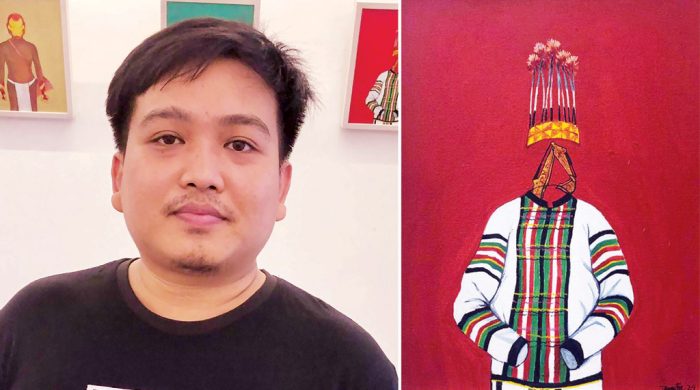An exhibition with a difference: Jayatu Chakma’s solo

- Update Time : Tuesday, April 30, 2024
- 44 Time View

Intensely political, Jayatu Chakma’s depiction of the motifs and lost memories of hill life with commendable artistry makes his solo exhibition a great feast for the eye. The exhibition is currently on, and will continue until May 14 at Kala Kendra, Lalmatia in the capital.
Jayatu Chakma, 34, is from Rangamati; had his BFA and MFA in painting at the Institute of Fine Arts, Chittagong University, followed by another MFA at Rabindra Bharati University, Kolkata, India. Prior to the present solo exhibition, he held another solo at Abanindranath Tagore Gallery, ICCR, Kolkata.
The title of the solo may sound a bit tricky to crack: Until the Rongrang Sings. Rongrang is an extinct bird of the hornbill (Dhanesh) variety notable for its huge golden beak and massive wings—once a much loved bird in the CHT hills, and indeed a spectacular beauty to watch. The fact is that the bird is extinct hints to the sense of loss and the metaphysics of lost memories in various shades and forms.
Anyone not particularly aware of life and living in the hills since the past sixty-plus years may unwittingly consider majority of Jayutu’s works as presentation of pastoral life of the indigenous people with a mix of the real and the abstract. But they are not so innocuous, to say the least. Not songs of innocence, as William Blake had once told us, contrasting innocence with the corrupting influence of what he coined as ‘experience’. There is no innocence in Jayatu’s canvas; his works are dense with undertones, often shockingly ghastly and gruesome. At the heart of most of his works is the calamity wrecked by the Kaptai dam. The dam, built in 1962, had vast swaths of fertile hilly crop lands (54,000 acres) inundated for good, rendering thousands of people internally displaced and another few thousands forced to leave their homeland for different destinations outside the country. An utterly ugly instance of majoritarian supremacy in modern times!
While the Kaptai dam had set off the misery, the succeeding narrative in the hills over the decades speaks of a long lingering tale of deprivation and state-sponsored cruelty. Jayatu Chakma has all these in the background while pondering on life that was and also on the present—the latter frayed by majoritarian nationalism. The symbol of the Rongrang is poignant in that it encapsulates the past and the present at the intersections of politics and social transactions.
The curator of the exhibition Sharmillie Rahman has aptly noted in the catalogue: ‘the entire oeuvre is strewn with visual semiosis associated with stories of illegitimisation, dismissal … social injustice wrought by the age-old paradigm of state vs. minority, power vs. the wretched of the earth.’
Besides acrylic and water colour paintings, Jayatu has banded together needle works, digital prints, and sculptures. As one begins to explore the expanse of his vision, it becomes clear that he has attempted to capture the hill life from the time of the Kaptai deluge to that of the present, by means of motifs and objects he considered relevant. There are faceless figures that one may find especially significant in conveying a sense of anonymity, inscrutability too, during the harshest times in the hills.
Jayatu has not given caption to any of his works—a suggestion perhaps for the undefined and the unexplained.
The exhibition with an ensemble of various types of art works deserves admiration in as much as they reflect the artist’s endeavour to delve into time and space to tell his tale in a manner he considers appropriate— the mastery of an artist who knows what he is up to.
Wasi Ahmed is a novelist, short story writer and essayist.















